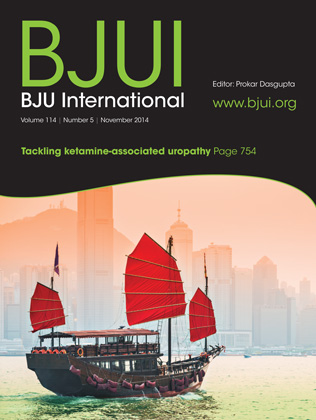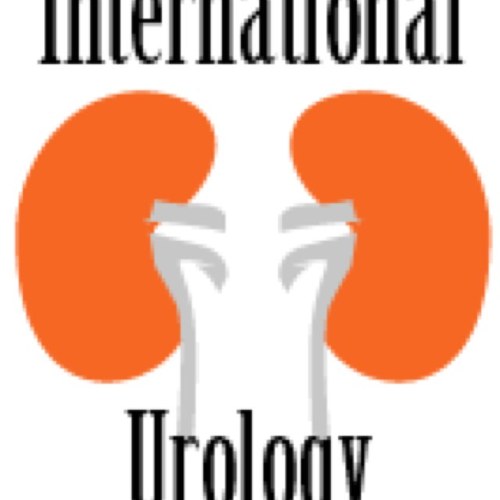
Editorial: Robotic and conventional open radical cystectomy lead to similar postoperative health-related quality of life
In this month's issue of BJU International, Messer et al. [1] devise a prospective randomised trial to compare postoperative health-related quality of life (HRQoL) after robot-assisted (RARC) vs conventional open radical cystectomy (ORC). The investigators evaluated 40 patients over a follow-up period of 1 year and found no significant difference in HRQoL between surgical approaches. Moreover, they showed that the postoperative decrease in HRQoL returns to baseline within 3 months of surgery.
RC…

BCG – An all or nothing treatment for NMIBC?
November 2014 ushered in the third year of the international urology journal club (@iurojc) and also marked the 2500th follower of @iurojc.
This month’s article was published in European Urology (@Uroweb) on October 10, 2014, Sequential Combination of Mitomycin C Plus Bacillus Calmette-Guerin (BCG) Is More Effective but More Toxic Than BCG Alone in Patients with Non-Muscle-Invasive Bladder Cancer in Intermediate- and High-risk Patients: Final Outcome of CUETO 93009, a Randomized Prospective…

Editorial: Statins and biochemical recurrence after radical prostatectomy – who benefits?
In the present issue of the BJUI Allott et al. [1] report results from a study where they used the Shared Equal Access Regional Cancer Hospital (SEARCH) database to explore the risk of biochemical recurrence (BCR) after radical prostatectomy (RP) among men who used statins after RP. They report improved BCR-free survival among statin users, especially among men with high-risk disease at baseline. The results provide some new insights into the current discussion on statins and prostate cancer…

Editorial: Evolution of extracorporeal shockwave lithotripsy (ESWL)
Much has changed since the introduction of extracorporeal shockwave lithotripsy (ESWL); however, in many ways the principles remain constant. This manuscript by Jagtap et al. [1] is a large series of patients over 25 years and encapsulates the changes in ESWL over that time. This paper has all the limitations inherent in a retrospective review but within this offers interesting data. In particular the use of two different machines and refinements in technique are eloquently described. This shows…

Editorial: ‘Discontent is the first necessity of progress’, Thomas A. Edison
This study from Kaag et al. [1] investigates predictors of renal functional decline after radical nephroureterectomy (RNU) in patients with upper tract urothelial carcinoma (UTUC). They evaluate early (2 months) and late (6 months) predictors of renal functional decline, finding that on a multivariable model only age at surgery and preoperative renal function were independently associated with early postoperative function. This is an intuitive finding whereby we expect older patients and those…

Lessons learned from Asian Urology
1 Comment
/
Glasgow has been in the news a lot this year. The fantastic Commonwealth Games were followed by an excellent Société Internationale d'Urologie (SIU) meeting with its unique Scottish flavour. This month we move our attention to two other nations that have hosted the SIU – China and India. We present two large studies, which are well worth your reading pleasure, not just because of their sheer size but also for their messages and citability.
Since the initial discovery in 2007 of ketamine-associated…

Step-by-Step. Real time TRUS-guided free-hands technique for focal cryoablation of the prostate
Real-time transrectal ultrasonography-guided hands-free technique for focal cryoablation of the prostate
Andre Luis de Castro Abreu, Duke Bahn*, Sameer Chopra, Scott Leslie, Toru Matsugasumi, Inderbir S. Gill and Osamu Ukimura
USC Institute of Urology, Catherine and Joseph Aresty Department of Urology, Center for Prostate Cancer Focal Therapy, Keck School of Medicine, University of Southern California, Los Angeles, and *Prostate Institute of America, Community…

Editorial: Where next in ketamine uropathy? Dedicated management centres?
Tam et al. [1] in this month's BJUI publish the largest prospective cohort to date on ketamine uropathy (KU). KU is a growing international problem since initial reports in 2007 from Canada and Hong Kong, where ketamine is second only to heroin in popularity amongst drug takers [2, 3]. Prevalence of KU may be higher than previously thought with up to a quarter of people misusing ketamine reporting urinary symptoms [4].
Importantly, the Tam et al. [1] paper demonstrates the benefit…

Editorial: Extent of lymph node metastases
The role of prostatectomy in lymph node metastasized prostate cancer has been subject to changing opinions. Classically, a nodal dissection was performed as the initial step in the procedure and prostatectomy was avoided in men with cryosection-proven metastases. Biochemical recurrence during the first 3 years occurs in the majority of men with pN1 disease [1]. Early data from randomized trials shows only a 50% prostate cancer-specific survival 12 years after prostatectomy and nodal metastases without…

Rocktober – Keep on rocking #urojc
We celebrated the two-year anniversary of the international urology journal club this month (@iurojc) with record participation. There were over 500 tweets in the 48 hour discussion of this month’s article, published in New England Journal of Medicine on September 18, 2014, Ultrasound versus Computed Tomography for Suspected Nephrolithiasis. It was a true multidisciplinary discussion with nephrologists, EM docs, and study author, radiologist Rebecca Smith-Bindman tweeting.
This was a multi-institutional…
